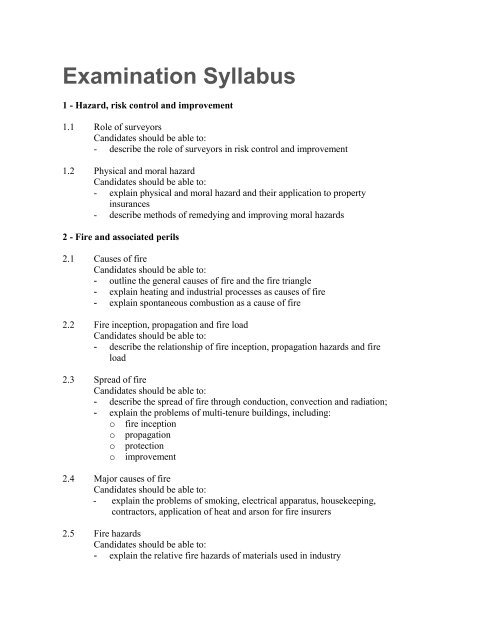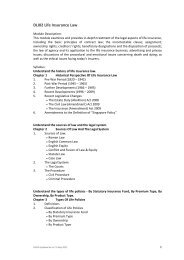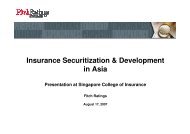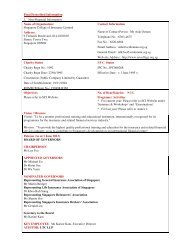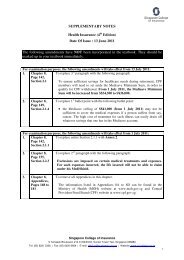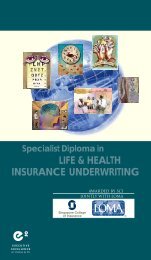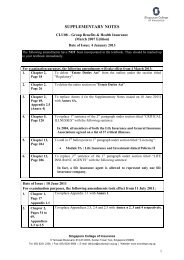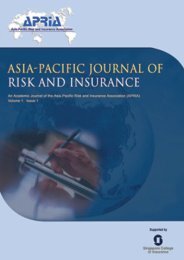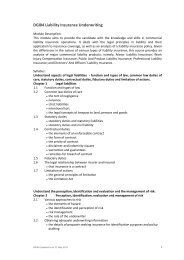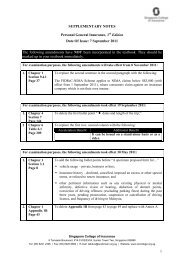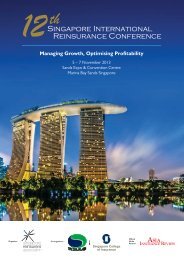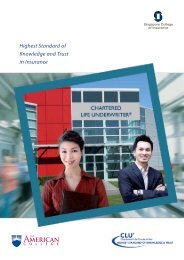Examination Syllabus - Singapore College of Insurance
Examination Syllabus - Singapore College of Insurance
Examination Syllabus - Singapore College of Insurance
You also want an ePaper? Increase the reach of your titles
YUMPU automatically turns print PDFs into web optimized ePapers that Google loves.
<strong>Examination</strong> <strong>Syllabus</strong><br />
1 - Hazard, risk control and improvement<br />
1.1 Role <strong>of</strong> surveyors<br />
Candidates should be able to:<br />
- describe the role <strong>of</strong> surveyors in risk control and improvement<br />
1.2 Physical and moral hazard<br />
Candidates should be able to:<br />
- explain physical and moral hazard and their application to property<br />
insurances<br />
- describe methods <strong>of</strong> remedying and improving moral hazards<br />
2 - Fire and associated perils<br />
2.1 Causes <strong>of</strong> fire<br />
Candidates should be able to:<br />
- outline the general causes <strong>of</strong> fire and the fire triangle<br />
- explain heating and industrial processes as causes <strong>of</strong> fire<br />
- explain spontaneous combustion as a cause <strong>of</strong> fire<br />
2.2 Fire inception, propagation and fire load<br />
Candidates should be able to:<br />
- describe the relationship <strong>of</strong> fire inception, propagation hazards and fire<br />
load<br />
2.3 Spread <strong>of</strong> fire<br />
Candidates should be able to:<br />
- describe the spread <strong>of</strong> fire through conduction, convection and radiation;<br />
- explain the problems <strong>of</strong> multi-tenure buildings, including:<br />
o fire inception<br />
o propagation<br />
o protection<br />
o improvement<br />
2.4 Major causes <strong>of</strong> fire<br />
Candidates should be able to:<br />
- explain the problems <strong>of</strong> smoking, electrical apparatus, housekeeping,<br />
contractors, application <strong>of</strong> heat and arson for fire insurers<br />
2.5 Fire hazards<br />
Candidates should be able to:<br />
- explain the relative fire hazards <strong>of</strong> materials used in industry
ii | Commercial Property Underwriting<br />
- describe the relative fire hazards <strong>of</strong> building construction and materials, including<br />
composite panels<br />
2.6 Methods <strong>of</strong> fire protection<br />
Candidates should be able to:<br />
- describe the methods <strong>of</strong> fire protection, including:<br />
o<br />
o<br />
upgrading <strong>of</strong> construction<br />
the provision <strong>of</strong> fire extinguishers, alarms, sprinklers, drenchers and private fire<br />
brigades<br />
- describe the methods <strong>of</strong> protection <strong>of</strong> computer equipment<br />
- describe the methods <strong>of</strong> protecting property from lightning damage<br />
2.7 Other hazards<br />
Candidates should be able to:<br />
- explain the explosion hazards <strong>of</strong> flammable liquids and gases and the methods <strong>of</strong><br />
reducing such risks<br />
- describe the hazards <strong>of</strong> dust explosions and the reduction <strong>of</strong> these risks<br />
- describe the hazards arising from perils <strong>of</strong> storm, flood, burst pipes, impact,<br />
malicious damage, riot and civil commotion, terrorism and subsidence and their<br />
control<br />
3 - Theft<br />
3.1 Nature <strong>of</strong> theft<br />
Candidates should be able to:<br />
- discuss the nature <strong>of</strong> theft risks, including:<br />
o area<br />
o type <strong>of</strong> property<br />
o security<br />
- explain the pattern <strong>of</strong> theft losses<br />
3.2 Security measures<br />
Candidates should be able to:<br />
- explain the criteria for security surveys<br />
- describe the nature <strong>of</strong> perimeter protection, surveillance, access control and security<br />
guards<br />
- describe the nature <strong>of</strong> door and window construction and its effect on protection<br />
- describe the types and use <strong>of</strong> intruder alarms<br />
- describe the selection and use <strong>of</strong> safes<br />
3.3 Protection<br />
Candidates should be able to:<br />
- describe the methods <strong>of</strong> protection <strong>of</strong> cash in transit<br />
- describe the protection <strong>of</strong> vehicles and goods in transit
<strong>Examination</strong> <strong>Syllabus</strong> | iii<br />
4 - Surveying<br />
4.1 Survey request<br />
Candidates should be able to:<br />
- explain the objective <strong>of</strong> a survey request to:<br />
o provide assessment <strong>of</strong> risk<br />
o improve commercial features <strong>of</strong> risk<br />
o <strong>of</strong>fer improvement benefits to all parties<br />
o develop loss prevention programmes<br />
4.2 Use and content <strong>of</strong> surveys<br />
Candidates should be able to:<br />
- explain the content, use and interpretation <strong>of</strong> survey and interruption reports<br />
4.3 Calculation <strong>of</strong> Estimated Maximum Loss<br />
Candidates should be able to:<br />
- discuss the calculation <strong>of</strong> EML (Estimated Maximum Loss) and insurer’s liability<br />
4.4 Underwriting considerations and risk pr<strong>of</strong>iles<br />
Candidates should be able to:<br />
- discuss the main underwriting considerations<br />
- explain the standard risk pr<strong>of</strong>iles and deviations therefrom<br />
4.5 Fidelity risks<br />
Candidates should be able to:<br />
- describe the basic systems <strong>of</strong> checking fidelity risks, including the use <strong>of</strong>:<br />
o references<br />
o employer ’s and employee ’s forms<br />
o survey <strong>of</strong> computer procedures<br />
4.6 Surveys<br />
Candidates should be able to:<br />
- explain the uses <strong>of</strong> resurveys and post-loss surveys<br />
5 - Underwriting – Property <strong>Insurance</strong><br />
5.1 The underwriter<br />
Candidates should be able to:<br />
- outline the tasks <strong>of</strong> the underwriter<br />
5.2 Underwriting information development and analysis<br />
Candidates should be able to:<br />
- outline the importance <strong>of</strong> underwriting information<br />
- describe the sources <strong>of</strong> information that an underwriter can access to
iv | Commercial Property Underwriting<br />
5.3 Hazard identification and risk evaluation<br />
Candidates should be able to:<br />
- describe the hazard or risk analysis factors are considered important in the overall<br />
evaluation <strong>of</strong> the risk to be insured, including:<br />
o process hazard analysis<br />
o physical hazard analysis<br />
o moral hazard analysis<br />
o claims analysis<br />
5.4 Risk selection and classification<br />
Candidates should be able to:<br />
- outline the importance <strong>of</strong> risk selection and classification<br />
5.3 Setting terms and conditions<br />
Candidates should be able to:<br />
- describe the important items that should be considered when determine the<br />
underwriting significance <strong>of</strong> insurance contract clauses and provisions<br />
5.4 Pricing<br />
Candidates should be able to:<br />
- describe the factors that an underwriter must consider when calculating an insurance<br />
premium to charge<br />
- discuss the factors affecting premium pricing<br />
- discuss the various methods <strong>of</strong> premium rating<br />
- state the significance <strong>of</strong> the use <strong>of</strong> information technology in premium calculations<br />
- discuss the factors to consider in rating adjustments<br />
- describe the treatment <strong>of</strong> risks that fall outside <strong>of</strong> the normal underwriting guidelines,<br />
and the underwriting <strong>of</strong> terrorism risk<br />
5.3 Risk optimisation and control <strong>of</strong> exposure<br />
Candidates should be able to:<br />
- discuss the theory <strong>of</strong> Estimated Maximum Loss underwriting<br />
- outline the considerations <strong>of</strong> setting retentions<br />
- describe the use <strong>of</strong> reinsurance to increase underwriting capacity and to protect<br />
against risk accumulations<br />
6 - Construction <strong>Insurance</strong><br />
6.1 Various types <strong>of</strong> construction risks and their main exposures<br />
Candidates should be able to:<br />
- discuss the typical risks and main exposures (causes <strong>of</strong> loss or damage)<br />
- discuss the construction operation and specific project risks<br />
- outline the general classification <strong>of</strong> project risks
<strong>Examination</strong> <strong>Syllabus</strong> | v<br />
6.2 Underwriting and assessment <strong>of</strong> construction risks<br />
Candidates should be able to:<br />
- discuss the importance <strong>of</strong> risk assessment and evaluation<br />
- describe the parties in a construction contract<br />
- outline the importance <strong>of</strong> contract conditions<br />
- explain how typical risks emanating from construction activities may be classified<br />
- describe the significance <strong>of</strong> the tender stage <strong>of</strong> the construction contract in risk<br />
assessment and evaluation<br />
- describe the basic information needed by underwriters in risk assessment and<br />
evaluation<br />
- outline the areas to be investigated when assessing the security and safety measures<br />
<strong>of</strong> a project<br />
- explain the importance <strong>of</strong> contractual aspects in risks assessment<br />
- outline the remedial approach to render risks acceptable<br />
- state the factors to be considered in the pricing <strong>of</strong> risks<br />
- distinguish between a single project policy and an annual policy<br />
- describe the advantages <strong>of</strong> an ‘open’ cover and explain why an ‘open’ cover is not<br />
generously granted by insurers<br />
- describe the underwriting considerations <strong>of</strong> an annual policy<br />
6.3 Reinsurance<br />
Candidates should be able to:<br />
- explain the application <strong>of</strong> reinsurance within Construction <strong>Insurance</strong><br />
- explain the workings <strong>of</strong> the various types <strong>of</strong> reinsurance<br />
7 - Engineering <strong>Insurance</strong><br />
7.1 Inspection and surveys <strong>of</strong> engineering plant and machinery<br />
Candidates should be able to:<br />
- discuss the purpose <strong>of</strong> inspections <strong>of</strong> engineering plant and machinery<br />
- discuss the purpose and use <strong>of</strong> surveys <strong>of</strong> engineering plant and machinery<br />
7.2 Boiler and pressure plant<br />
Candidates should be able to:<br />
- discuss issues affecting cover for boiler and pressure plant, including:<br />
o typical items <strong>of</strong> plant and main causes <strong>of</strong> loss or damage<br />
o risk assessment and underwriting<br />
7.3 Electrical and mechanical plant<br />
Candidates should be able to:<br />
- discuss issues affecting cover for electrical and mechanical plant, including:<br />
o typical items <strong>of</strong> plant and main causes <strong>of</strong> loss or damage<br />
o risk assessment and underwriting
vi | Commercial Property Underwriting<br />
7.4 Lifts, cranes and handling equipment<br />
Candidates should be able to:<br />
- discuss issues affecting cover for lifts, cranes and handling equipment, including:<br />
o typical items and main causes <strong>of</strong> loss or damage<br />
o risk assessment and underwriting<br />
7.5 Engineering and its potential effect on the environment<br />
Candidates should be able to:<br />
- explain the impact <strong>of</strong> engineering and its potential effect on the environment<br />
7.6 Reinsurance<br />
Candidates should be able to:<br />
- explain the application <strong>of</strong> reinsurance to Engineering <strong>Insurance</strong><br />
7.7 Risks insured <strong>of</strong> non-inspected classes<br />
Candidates should be able to:<br />
- describe the standard risks insured under non-inspected classes, including:<br />
o computers<br />
o machinery movement<br />
o deterioration <strong>of</strong> stocks<br />
o miscellaneous plant<br />
o storage tanks<br />
7.8 Risk insured <strong>of</strong> non-inspected classes (special lines)<br />
- describe the issues affecting risk assessment, technical inspection and underwriting <strong>of</strong><br />
the following non-inspected classes:<br />
o latent defects insurance<br />
o pr<strong>of</strong>essional indemnity insurance<br />
o contract guaranteed bonds<br />
o civil engineering completed risks<br />
8 - Business Interruption relating to Engineering and Construction <strong>Insurance</strong>s<br />
8.1 Engineering Business Interruption <strong>Insurance</strong><br />
Candidates should be able to:<br />
- discuss issues affecting Engineering Business Interruption <strong>Insurance</strong>, including:<br />
o objective <strong>of</strong> the cover<br />
o risk assessment<br />
o risk management<br />
o underwriting<br />
8.2 Construction Business Interruption <strong>Insurance</strong><br />
Candidates should be able to:<br />
- discuss the issues affecting Construction Business Interruption <strong>Insurance</strong>, including:<br />
o objective <strong>of</strong> the cover
<strong>Examination</strong> <strong>Syllabus</strong> | vii<br />
o risk assessment<br />
o risk management<br />
o underwriting<br />
8.3 Loss <strong>of</strong> advance rent and interest<br />
Candidates should be able to:<br />
- outline the reasons for coverage <strong>of</strong> loss <strong>of</strong> advance rent and interest<br />
9 - Marine <strong>Insurance</strong><br />
9.1 Policy forms<br />
Candidates should be able to:<br />
- state the characteristics <strong>of</strong> the Marine <strong>Insurance</strong> policy form, including slip policies<br />
9.2 Valued and unvalued policies<br />
Candidates should be able to:<br />
- distinguish between valued and unvalued policies<br />
9.3 Warranties<br />
Candidates should be able to:<br />
- discuss the characteristics and use <strong>of</strong> warranties in Marine <strong>Insurance</strong><br />
9.4 Hull and cargo clauses<br />
Candidates should be able to:<br />
- describe the cover and exclusions <strong>of</strong> the International Hull Clauses 1/11/03<br />
- identify the key differences in cover and exclusions between the above and the<br />
Institute Time Clauses (Hulls) 1/10/83 and 1/11/95<br />
- describe the cover and exclusions <strong>of</strong> the Institute Cargo Clauses (A), (B) and (C)<br />
1/1/82<br />
- list the other common trade clauses established for selected trades<br />
- describe the purpose <strong>of</strong> the Institute Classification Clause 1/8/97<br />
9.5 Rating <strong>of</strong> marine risks<br />
Candidates should be able to:<br />
- explain the main factors which determine the rate <strong>of</strong> premium charged for hulls and<br />
cargo<br />
9.6 Use <strong>of</strong> Experts<br />
Candidates should be able to:<br />
- outline the use <strong>of</strong> surveyors and average adjusters in claims handling<br />
9.7 Application <strong>of</strong> reinsurance<br />
Candidates should be able to:<br />
- explain the application <strong>of</strong> the various methods <strong>of</strong> reinsurance to Marine <strong>Insurance</strong>
viii | Commercial Property Underwriting<br />
10 - Aviation insurance<br />
10.1 Types <strong>of</strong> policy<br />
Candidates should be able to:<br />
- outline the main types <strong>of</strong> aviation policy<br />
10.2 Hull and liability policy forms<br />
Candidates should be able to:<br />
- describe the main policy forms and their use in Aviation Hull And Liability <strong>Insurance</strong><br />
10.3 Scope <strong>of</strong> cover<br />
Candidates should be able to:<br />
- explain the scope <strong>of</strong> cover provided by aviation policies and clauses<br />
- identify the main policy exclusions<br />
10.4 Rating <strong>of</strong> aviation risks<br />
Candidates should be able to:<br />
- discuss the factors which affect the risk<br />
- discuss the methods used to determine the rate for the premium<br />
10.5 Use <strong>of</strong> experts<br />
Candidates should be able to:<br />
- describe the roles <strong>of</strong> experts in Aviation <strong>Insurance</strong><br />
10.6 Application <strong>of</strong> reinsurance<br />
Candidates should be able to:<br />
- explain the application <strong>of</strong> the various methods <strong>of</strong> reinsurance to Aviation <strong>Insurance</strong><br />
11 - Energy <strong>Insurance</strong><br />
11.1 Risk assessment<br />
Candidates should be able to:<br />
- discuss the main risk assessment and rating factors applicable to the underwriting <strong>of</strong>:<br />
o exploration risks<br />
o construction risks<br />
o operational risks<br />
o operators’ extra expenses risks<br />
11.2 Business Interruption and control <strong>of</strong> well<br />
Candidates should be able to:<br />
- discuss the importance <strong>of</strong> Business Interruption<br />
- explain how the Business Interruption <strong>Insurance</strong> works<br />
- describe the advantages and disadvantages <strong>of</strong> Business Interruption <strong>Insurance</strong><br />
- discuss the methods and importance <strong>of</strong> control <strong>of</strong> well
<strong>Examination</strong> <strong>Syllabus</strong> | ix<br />
11.3 Deductibles and limits<br />
Candidates should be able to:<br />
- explain the application <strong>of</strong> deductibles and limits to the underwriting <strong>of</strong> energy risks<br />
11.4 Accumulation<br />
Candidates should be able to:<br />
- describe the effects <strong>of</strong> accumulation<br />
- explain the methods used for and the importance <strong>of</strong> controlling accumulation<br />
11.5 Statistics and other information<br />
Candidates should be able to:<br />
- outline the main statistics and information used in underwriting <strong>of</strong> energy risks<br />
- identify the various sources <strong>of</strong> this information<br />
- apply it practically to the underwriting <strong>of</strong> energy risks<br />
11.6 War, strikes and terrorism<br />
Candidates should be able to:<br />
- discuss the effect <strong>of</strong> war, strikes and terrorism on the underwriting <strong>of</strong> energy risks<br />
11.7 Clauses<br />
Candidates should be able to:<br />
- explain the cover provided and not provided by the various market policy forms,<br />
including:<br />
o London standard drilling barge form<br />
o <strong>of</strong>fshore construction standard form<br />
o energy exploration and development form<br />
11.8 Claims<br />
Candidates should be able to:<br />
- describe the main players involved in claims<br />
- explain the main types <strong>of</strong> claims, including business interruption arising under:<br />
o exploration risks<br />
o operational risks<br />
o construction risks
x | Commercial Property Underwriting


